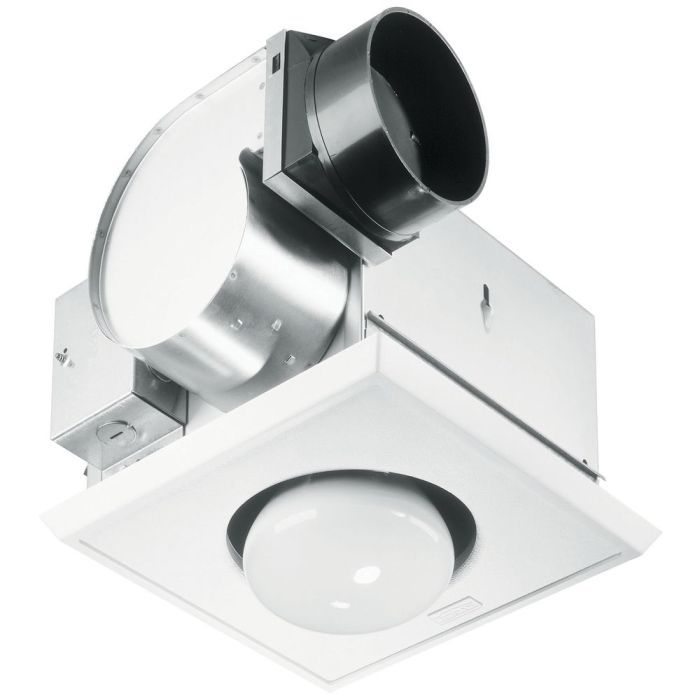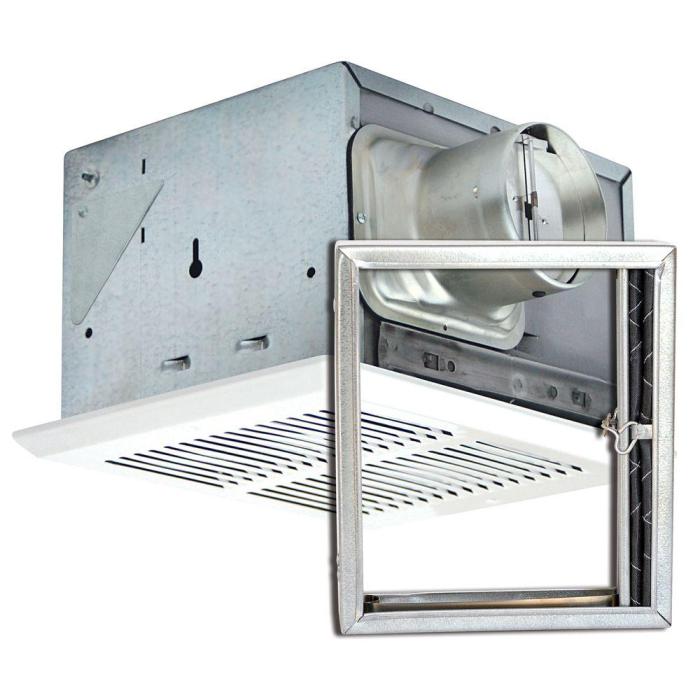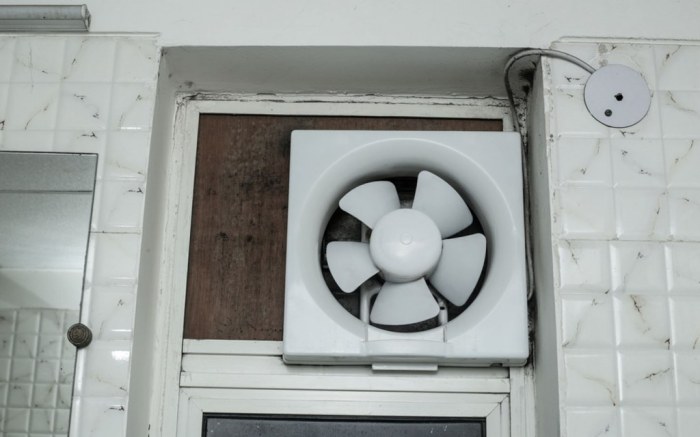When it comes to maintaining a healthy and comfortable bathroom environment, effective ventilation is paramount. Exhaust fans play a crucial role in removing excess moisture, odors, and pollutants, preventing the growth of mold and mildew. However, in humid bathroom settings, regular exhaust fans can succumb to rust and corrosion, reducing their lifespan and compromising their performance.
This guide will delve into the world of rust-resistant bathroom exhaust fans, exploring their materials, features, installation, maintenance, and applications to help you make informed choices for lasting bathroom ventilation.
Rust-resistant exhaust fans are engineered with durable materials and advanced features to withstand the harsh conditions of bathrooms. By understanding the key considerations and benefits of these fans, you can ensure optimal air quality, prevent moisture buildup, and extend the lifespan of your bathroom ventilation system.
Materials and Design Considerations for Rust-Resistant Exhaust Fans
Installing rust-resistant bathroom exhaust fans is crucial to ensure longevity and maintain a healthy bathroom environment. Rust can accumulate due to moisture and humidity, leading to fan malfunctions and reduced efficiency. Rust-resistant materials offer durability, ensuring optimal performance over an extended period.
Various materials are employed for rust-resistant exhaust fans, each with its advantages and disadvantages. Let’s explore the most common options:
Stainless Steel
Stainless steel is an excellent choice for rust resistance due to its corrosion-resistant properties. It withstands moisture and humidity effectively, making it ideal for bathrooms. Stainless steel fans are durable, easy to clean, and maintain their appearance over time.
Aluminum
Aluminum is another rust-resistant material used in exhaust fans. It is lightweight, durable, and corrosion-resistant, making it a suitable option for humid environments. Aluminum fans are often coated with a protective finish to enhance their rust resistance further.
Plastic
Plastic is a budget-friendly option for rust-resistant exhaust fans. It is lightweight and resistant to moisture and humidity. However, plastic fans may not be as durable as metal fans and may discolor over time due to UV exposure.
Specific Fan Models with Exceptional Rust Resistance
- Broan-NuTone Nutone 682 Exhaust Fan: This fan features a galvanized steel housing and a plastic grille, ensuring rust resistance in humid environments.
- Panasonic FV-30VQ5 Exhaust Fan: Constructed with a stainless steel housing and a plastic grille, this fan offers exceptional corrosion resistance and durability.
- Delta Electronics Breez GreenBuilder Exhaust Fan: With a polymeric housing and grille, this fan is designed to withstand moisture and humidity, making it ideal for bathrooms.
Features and Functionality of Rust-Resistant Exhaust Fans
Rust-resistant exhaust fans are designed to withstand the humid and corrosive environment of bathrooms, ensuring optimal performance and longevity. When selecting a rust-resistant exhaust fan, consider the following key features:
CFM Rating: Cubic Feet per Minute (CFM) measures the airflow capacity of an exhaust fan. Higher CFM ratings indicate a more powerful fan that can effectively remove moisture and odors from larger bathrooms. Choose a fan with a CFM rating appropriate for the size of your bathroom.
Noise Level: Exhaust fans can generate noise, which can be a concern in bathrooms where privacy is desired. Look for fans with low noise levels, measured in sones or decibels. Quieter fans provide a more comfortable environment without sacrificing performance.
Energy Efficiency: Energy-efficient exhaust fans consume less electricity, reducing your energy bills. Look for fans with ENERGY STAR certification, which indicates compliance with strict energy efficiency standards.
Advancements in Exhaust Fan Technology
Recent advancements in exhaust fan technology have further enhanced rust resistance and functionality:
- Polymer Housing: Some fans feature polymer housings that are highly resistant to corrosion, even in harsh environments.
- Sealed Bearings: Sealed bearings protect the motor from moisture and debris, extending the fan’s lifespan.
- Automatic Shut-Off: Advanced fans may include automatic shut-off features that prevent overheating and ensure safe operation.
Installation and Maintenance for Rust-Resistant Exhaust Fans
Proper installation and regular maintenance are crucial for ensuring the longevity and optimal performance of rust-resistant exhaust fans. Here are some essential considerations:
Installation
1.
-
-*Choose the Right Location
Determine the appropriate location for the fan based on the size of the room, ventilation requirements, and proximity to moisture sources.
- 2.
- 3.
- 4.
- 5.
-*Prepare the Opening
Cut a hole in the ceiling or wall according to the fan’s dimensions. Ensure the opening is level and secure.
-*Mount the Fan
Install the fan housing into the opening and secure it with screws or brackets.
-*Connect the Wiring
Follow the manufacturer’s instructions to connect the fan’s electrical wires to the power source.
-*Seal the Gaps
Use caulk or weatherstripping to seal any gaps between the fan and the wall or ceiling to prevent air leakage.
Maintenance
1.
-
-*Regular Cleaning
Remove dust and debris from the fan blades and housing using a soft cloth or vacuum cleaner.
- 2.
- 3.
-*Lubrication
Lubricate the fan motor regularly (as per the manufacturer’s instructions) to reduce friction and extend its lifespan.
-*Troubleshooting
If the fan is not working properly, check for common issues such as:
Power supply issues (check electrical connections)
Motor failure (may require professional repair)
Clogged fan blades (clean or replace)
Applications and Benefits of Rust-Resistant Exhaust Fans
Rust-resistant exhaust fans are designed to withstand the humid and moisture-rich environments commonly found in bathrooms, kitchens, and laundry rooms. These fans play a crucial role in improving indoor air quality, reducing moisture levels, and preventing the growth of mold and mildew.
In bathrooms, rust-resistant exhaust fans help remove excess moisture from showers and baths, preventing condensation from accumulating on walls, ceilings, and mirrors. This reduces the risk of mold and mildew growth, which can cause respiratory problems and other health issues.
In kitchens, rust-resistant exhaust fans help remove cooking fumes, odors, and grease from the air. This improves indoor air quality and reduces the risk of fire hazards caused by grease buildup.
In laundry rooms, rust-resistant exhaust fans help remove moisture from clothes dryers, preventing condensation from damaging walls and ceilings. This also helps reduce the risk of mold and mildew growth.
Case Study:
A recent study conducted by the Environmental Protection Agency (EPA) found that the installation of rust-resistant exhaust fans in bathrooms and kitchens significantly reduced indoor air pollution levels. The study also found that the fans helped reduce the growth of mold and mildew, improving the overall health and well-being of the occupants.
Comparison of Rust-Resistant Exhaust Fans
When choosing a rust-resistant exhaust fan, it’s crucial to compare different models to find the best fit for your needs. This table compares several popular options based on key features, performance, and price, helping you make an informed decision.
Consider factors such as fan size, CFM (cubic feet per minute) rating, noise level, and energy efficiency when selecting a fan. Also, check the warranty and customer reviews to ensure reliability and satisfaction.
Model Comparison Table
| Feature | Model A | Model B | Model C |
|---|---|---|---|
| Fan Size (inches) | 6″ | 8″ | 10″ |
| CFM Rating | 110 | 150 | 200 |
| Noise Level (sones) | 2.5 | 3.0 | 3.5 |
| Energy Efficiency (CFM/Watt) | 10 | 12 | 14 |
| Warranty | 5 years | 3 years | 2 years |
| Price Range | $50-$70 | $70-$90 | $90-$120 |
Strengths and Weaknesses
- Model A: Compact size, low noise, affordable
- Model B: Higher CFM rating, energy-efficient
- Model C: Largest fan size, highest CFM rating, but noisier and more expensive
Buying Guide
To choose the best rust-resistant exhaust fan, consider the following:
- Fan Size: Determine the appropriate fan size based on the room’s square footage.
- CFM Rating: Higher CFM ratings indicate better ventilation.
- Noise Level: Consider the fan’s noise level, especially if it will be used in a quiet area.
- Energy Efficiency: Look for fans with high CFM/Watt ratings for energy savings.
- Warranty: A longer warranty ensures peace of mind and product longevity.
Final Summary
Investing in a rust-resistant bathroom exhaust fan is a wise choice for maintaining a healthy and comfortable bathroom environment. By considering the materials, features, installation, maintenance, and applications discussed in this guide, you can select a fan that meets your specific needs and provides lasting ventilation performance.
Remember, a well-ventilated bathroom not only enhances your comfort but also contributes to the overall health and longevity of your home.



